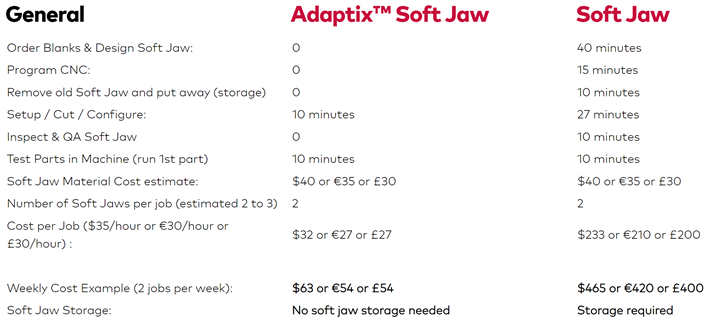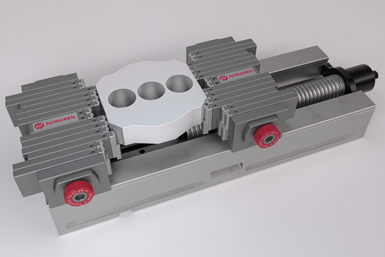Versatile Soft Jaw Introduces One-Size-Fits-All Technology
This soft jaw technology conforms to any part geometry and does not require removal from the machine tool when switching to a new job. It also saves shops setup and machining time, energy, and cost involved in the design and development of creating a custom soft jaw.
Designing and machining traditional soft jaws can be a burden on any machine shop, as producing them draws upon valuable time, materials, tooling, labor and cost that should ultimately be spent machining customers’ parts. Likewise, storing different soft jaws for possibly thousands of recurring jobs can take up valuable floor space in a shop.
Norgren, a workholding products manufacturer, was experiencing this soft jaw overflow at one of its Pennsylvania plants. Realizing the issues caused by manufacturing all these soft jaws, the company decided there must be a better way.
While searching for an alternative, Norgren created Adaptix, a singular adjustable soft jaw concept for CNC milling that replaces the need for designing and machining new soft jaws for every different part order that comes through the door.
According to Tom Wood, senior director of growth initiatives at Norgren, the company polled its machine shop partners around the globe about its new technology. “We reached out to them first to ask if they thought a new concept we had developed (Adaptix) was something they would be interested in, and they said yes. So, we started working with them and went from there.”
Adaptix features two rows of pins or “fingers” that are tall, thin steel plates that slide to come in contact with the part and hold it with sufficient force no matter its shape.
The soft jaw was created to stay mounted on a milling machine’s table and be adjusted while in place inside the machining zone. When a job comes along, the side knob on the jaw can be turned by hand to dial in the amount of drag on the fingers to position it for clamping the workpiece shape. Then, the part gets pushed into the jaw. “As you close your vise, you can let the fingers conform to that shape,” Wood explains. “Then, once you get what you want to contact on the part, you can decide to remove a couple of fingers, if necessary.”
After that, the operator locks down the lock bolt on the side to the specified torque, he continues. “From there, you use it just like a normal vise.”
If there is more than one of the same parts that must be machined, Wood hopes users understand they do not need to move the fingers when machining the second, third, and so on part. “Once you get the fingers set for the first part, you lock them in, and then you can open and close the vise like you normally would. Then, that shape is held just like a normal soft jaw,” he says. “Then, you can pop in the second part and so on by simply tightening the vise, as opposed to moving the fingers.”
Exchangeable Tips
The fingers use exchangeable tips that are available in either aluminum, steel, plastic, brass and other materials of choice to enable different shapes and step profiles, and to be compatible with the materials being gripped. The tips also are available in different shapes, including round and hex.

The time, energy and material savings that Adaptix provides are significant compared with its traditional counterpart.
The fact that these tips are exchangeable is significant because some workpiece materials may require a softer or harder material tip so as not to damage the workpiece. And, if the part is constructed with more than one material type, the tips on one soft jaw can be mixed, thereby offering different tolerances at different locations on the workpiece.
Adaptix can open the door to new opportunities for milling jobs for a machine shop that specializes in turning but has milling capabilities.
Creating select points of contact to the workpiece is another way to take advantage of Adaptix’s flexibility. Instead of creating a conventional soft jaw to fit a particular workpiece shape, this soft jaw can be designed to hold only a couple of points on the workpiece. Although it is possible to design a conventional soft jaw this way, the programmer needs to have the skill set and experience to understand when that design can be beneficial for an application, says Corey Shidler, applications engineer, Norgren.
Although this soft jaw is targeted toward unique workpiece shapes, it was made to change back easily and quickly to a typical job.
Tips for Best Applications
Shidler says Adaptix is most useful for high-mix, low-volume milling applications as well as prototype R&D and one-off jobs where frequent changeovers are required. For longer production runs, traditional soft jaws might make more sense.
This soft jaw currently accommodates a 6-inch maximum workpiece. Norgren is working on an 8-inch soft jaw, and the company also sees the need for a smaller soft jaw and different size fingers, too.
However, Wood has spoken with high-volume shops with tool rooms that are interested in Adaptix. He says some often make modifications to rework a part that has dedicated tooling. Therefore, this type of soft jaw can be beneficial.
He also states that Adaptix can open the door to new opportunities for milling jobs for a machine shop that specializes in turning but has milling capabilities.
This soft jaw currently accommodates a 6-inch maximum workpiece. “The fingers are 10-mm wide, so the part must be greater than the 10-mm wide clamping area for it to make sense to use,” Wood explains. “You want a minimum of two of the tips engaged.”
Also, Norgren is working on an 8-inch soft jaw, and the company also sees the need for a smaller soft jaw and different size fingers, too.
Is Maintenance Necessary?
According to Wood and Shidler, the only maintenance Adaptix requires is cleaning out chips or fluid produced during the machining process. They say there are only a couple of areas where chips can enter the jaw, and they are easily cleaned out. If it is necessary to do a more thorough cleaning, the jaw can be completely disassembled and reassembled without any special tools. If very fine chips enter between the fingers, the fingers are designed to be easily pulled out and put back in after cleaning.
The same is true if damage occurs during machining that necessitates the replacement of a finger. The bolt that holds the fingers together can be loosened, which enables an operator to pull out a damaged one and replace it with a new one.
As Norgren continues to work with the machine shop community, it is realizing new ways to use Adaptix that it would not likely learn on its own. “We think there are a lot of interesting ways to use the soft jaw that we haven’t even thought of yet,” Wood says.
To see a demo of the Adaptix soft jaw, watch this video.
Norgren | norgren.com
Related Content
German Project Yields Three New Medical Machining Processes
Recent research has resulted in a new mix of high-speed turn whirl milling, polygon turning and rotational turning for manufacturing medical bone screws and out-of-round nails.
Read MoreThe Value of Tool Monitoring on Rotary Transfer Machines
By using a tool monitoring system, shops can save costs associated with machine maintenance and downtime for tool changes while increasing cutting performance.
Read MoreBreaking the Barriers for Small Tool Breakage Detection
This contact-free tool breakage detector, especially useful for machine tools with small tools and small workzones, offers a quick and efficient way to change out broken tools before they cause bigger problems.
Read MoreWhat Is Trochoidal Turning? How Might Shops Benefit From It?
While trochoidal milling might be a more well-known toolpath strategy, trochoidal turning can offer similar benefits such as high material removal rates especially for rough-turning operations.
Read MoreRead Next
Adaptix Soft Jaw Provides One-Size-Fits-All Workholding Process
Adaptable soft jaw is designed to streamline CNC machining process and provide a one-size-fits-all way to enhance workholding efficiency.
Read MoreDo You Have Single Points of Failure?
Plans need to be in place before a catastrophic event occurs.
Read MoreEmerging Leaders Nominations Now Open
Here’s your chance to highlight a young person in your manufacturing business who is on the path to be a future leader moving your company forward.
Read More











.png;maxWidth=300;quality=90)












